Author :
Abstract
Keywords
Abstract
The aim of the study is to determine the effects of using TV series to improve EFL students' listening achievement levels in English. Another aim of the study was to reveal the perceptions of EFL students about the use of TV series in English to improve their listening proficiency. To this end, the study was conducted as a mix-method study that includes 30 EFL students. The participants of the study were chosen via convenience sampling. The data of the study were collected through pre-and post-achievement tests, a questionnaire and semi-structured interviews. While the data acquired via pre and post-tests and questionnaires were analyzed by using SPSS 25 Statistical Package, the data obtained through semi-structured interviews were examined by adopting a categorical-content analysis approach. The study results uncovered that the use of English TV series improved EFL students' listening achievement levels. It was also revealed the fact that EFL students thought that watching TV series contributed to their success in the classroom, and they believed that watching TV series in English improved their listening comprehension. The results of the study also showed that TV series could catch the learners' interest, and they can positively affect their motivation to improve their listening proficiency.
Keywords
- Bajrami, L. and Ismaili, M. (2016). The Role of Video Materials in EFL Classrooms. Procedia, social and behavioral sciences 232, 502–506.
- Çakir, D. I. (2006). The use of video as an audio-visual material in foreign language teaching classroom. The Turkish Online Journal of Educational Technology, 5(4), 67-72.
- Çilek, S. (2004). An applied study of close-captioned video on advanced students of English as listening comprehension material. (Unpublished Master Thesis). Selcuk University, Konya.
- Davis, F. D. (1989). Perceived usefulness, perceived ease of use, and user acceptance of information technology. MIS quarterly, 319-340.
- Ekinci, M. (2017). The Effects of Subtitled Animation Movies on The Listening Skills of
- Ekinci, E., & Ekinci, M. (2020). VoScreen As a Listening Aid: A Digitalized Learning Experience. International Journal of Languages' Education and Teaching, 8(3),
- Fazey, M. (1999). Guidelines to help instructors help their learners get the most out of video lessons. Unpublished manuscript. (Available from Kentucky Educational Television, Lexington, KY)
- Goldman, M., & S. Goldman. (1988). Reading with closed-captioned TV. Journal of Reading, 458-461.
- Grigoryan, T. (2018). Investigating Digital Native Female Learners' Attitudes towards Paperless Language Learning. Research in Learning Technology, 26.
- Hung, S. A. (2016). Enhancing Feedback Provision Through Multimodal Video
- Ismaili, M. (2013). The Effectiveness of Using Movies in the EFL Classroom –A Study Conducted at South East European University. Academic Journal of Interdisciplinary Studies, p. 121-132.
- King, J. 2002. Using DVD feature films in the EFL classroom. Computer Assisted Language Learning 15, no. 5: 509–23.
- Kusumarasdyati (2004). Listening, Viewing and Imagination: Movies in EFL Classes. 2nd International Conference on Imagination and Education Vancouver, Canada, July 14, 17, 2004.
- Lech, I. B. and Harris, L. N. (2019). Language Learning in the Virtual Wild. In M.L.
- Lin, L-Y. (2000). Manipulating DVD technology to empower your teaching. students. Selected Papers from the Ninth International Symposium on English Teaching. Taipei, Taiwan, 431-438.
- Littlewood, W. (1981). Communicative language teaching: An introduction. Cambridge University Press.
- Luo, J. J. (2004). Using DVD films to enhance college freshmen's English listening comprehension and motivation. Unpublished Master thesis, National Tsing Hua University, Hsinchu. Taiwan, ROC.
- Oura, G. (2001). Authentic Task-Based Materials: Bringing The Real World Into the Classroom.
- Özgen, M. (2008). İngilizce öğretiminde özgün altyazılı video’nun dinleme-algılama materyali olarak kullanımı. Unpublished M.A. Thesis, Selçuk University, Konya.
- Rosen, Y. (2009). The effects of an animation-based online learning environment on the transfer of knowledge and on motivation for science and technology learning. Journal of Educational Computing Research, 40(4), 451-467.
- Strange. J. & Strange, D. (1991). Survey: Video Materials. ELT Journal, 45, 335-359.
- Vandergrift, L. (2004). Listening to learn or learning to listen? Annual Review of Applied Linguistics, 24, 3-25.
- Yılmaz, H., & Yavuz, F. (2015). The Problems Young Learners Encounter During Listening Skills. Procedia-Social and Behavioral Sciences, 197, 2046-2050.





